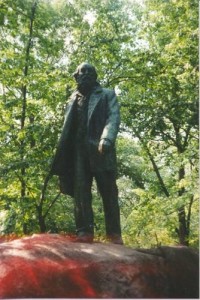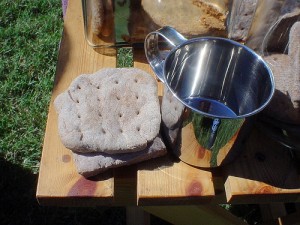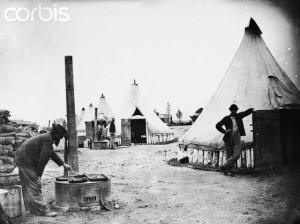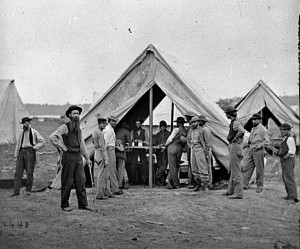Sam P.’s Final Project (In Search of Wendell Slickman)
Filed under: Uncategorized
Here is my long-undelivered final project, a hybrid of Walt Whitman and Elvis Presley. Please watch–it finally exists!
And here is the brief paper commenting on the chaos I have tried to control:
All These I Feel or Am:
Whitman as Hip-Shaker, Self-Promoter, and Idol
By reading Walt Whitman (the poet; the icon) through the images and sounds/musical attitudes associated with Elvis Presley, and creating the hybrid character Wendell Slickman, I originally intended to investigate the general cast of American celebrity. Presley and Whitman, by my original thesis, could be used to trace a shared (and therefore repeated/repeatable) pattern of ascendancy in the American public eye, relying first on a provocative, highly sexualized presentation to garner early celebrity, and then on a mid-to-late-career campaign to sanitize that sexual image in favor of a more wholesome, continent-encompassing form of American iconicity. The result would have been a relatively linear narrative, possible to tell in a video that spoke from beginning to end.
I almost misled myself. In actuality, Whitman and Presley evince both impulses, to sexually sensationalize and to self-sanctify, from the beginnings of their careers onward. I also realized, and just as pressingly, that my goal was not to use Whitman and Presley as equal partners in a sweeping commentary on American cultural mores. Instead, Presley serves as a sort of shorthand for the ICONIC AMERICAN, while his libido-flaunting musical medium allows me to reify the more dramatically performative aspects of “Song of Myself.” The rock ‘n’ roll documentary, a standard venue for discussing rock musicians that comes fraught with its own stylistic baggage, further allows me a set of characters—performer, commentator, collaborators—that help dramatize what I take to be the central textual enterprise of “Song of Myself”: integrating vastly disparate types of narrative authority into an identifiably central voice, a single figure from which radiates both the kosmos and a set of aphoristic claims large enough to fit it. Whitman essentially creates that core presence by constantly asserting it, thus presenting an illusion of unity that, if not for the force of his repetitive self-assertion, might easily break apart into disconnected (catalogic) observations, or splinter into disconnected speakers for every different voice or style he absorbs.
Much like Elvis, but to an arguably lesser degree, Whitman stands among a rarefied class of American figures whose fame and cultural relevance derive in great part from heavily disseminated images of him, prompting many American cultural consumers to “assume they know Whitman the poet because they are familiar with some graphic image of him” (Allen 128). That image most frequently follows the template laid out by William Douglas O’Connor, one of Whitman’s so-called disciples, in a pamphlet that gave Whitman the moniker that has long stood as an emblem of his literary/cultural latter-day sainthood. “The Good Gray Poet: A Vindication,” published in 1867, valorizes Whitman repeatedly to the point of Christliness, proclaiming that Whitman’s “is the great goodness, the great chastity of spiritual strength and sanity” (2). Bridging the apparent gulf between this image and Elvis’ venerated hip-shaking, O’Connor goes to great rhetorical lengths to characterize Whitman as “one of the greatest sons of men” at least nominally because the poet had just been dismissed from the Department of the Interior due to the supposed immorality of the 1860 Leaves of Grass (Blake 186). Whitman’s unblinking acknowledgment of the “disorderly fleshy and sensual” (Library of America 50) constitutes the immorality discovered in his work. But quite significantly, O’Connor defends that “fleshiness” as just the quality that dignifies Whitman’s writing.
“The Good Gray Poet” calls up the “indecent passages” created by a litany of other writers, like Shakespeare, Dante, Plutarch, Virgil, Goethe, and Byron—those “among the demi-gods of human thought” (O’Connor 8)—and even invokes the Bible’s references to genitalia and sexual contact, in order to color Whitman’s supposed indecency with a golden holiness. Though O’Connor’s efforts may seem like little more than good discipleship, his pamphlet’s broad and persistent influence has allowed even Whitman’s current readers to inherit an impression of the poet as something of an American apostle, while the pamphlet originating the “good gray poet” title sanctifies Whitman’s performance of sexuality, if not necessarily homoerotic desire, as an expression of his natural godliness. This management of Whitman’s iconic status bears striking resemblance to the common pop-culture impulse to spiritualize eroticism and deify sexy performers, an impulse represented perhaps most popularly by Elvis fans’ desire to both lust after and create shrines to “the King,” untroubled by the possible contradiction between those two acts (Doss 76).
However, Whitman’s followers cannot be held entirely responsible for their emphasis on the godliness of Whitman’s sexiness—not when the poet’s own writings champion that same conceptual transformation. Starting with the 1855 version of “Song of Myself,” long before Whitman and his handlers had retroactively consolidated a better (“good-er?”), grayer Poet persona, the poet delivered this avowal: “Magnifying and applying come I, / Outbidding at the start the old cautious hucksters, / The most they offer for mankind and eternity less than a spirt of my own seminal wet, / Taking myself the exact dimensions of Jehovah and laying them away” (Library of America 73). Whitman’s speaking persona here not only endows his sexuality with kosmic significance, linking his “seminal wet” with “offers” made to “mankind and eternity,” but also suggests by this stanza’s sequence that the same “seminal spirt” might equal the “dimensions of Jehovah.” Sex and spirituality thus emanate in like proportion from the single poetic/priapic source. Why? How? In large part, because the persona says so.
Whitman’s rhetorical practice in “Song of Myself” finds him both enacting and attempting to neutralize this tension between the flesh-man and the prophetic poet, taking on voices that switch unpredictably from the erotic to the elegiac, and from unrestrained sexuality to reverent self-commentary. For example, Whitman lends the passage of “Song of Myself” most frequently described as an orgasm an aftershock denouement that remains in the kind of explicit but elevated hyper-phallicism that precedes climax: “Sprouts take and accumulate…. stand by the curb prolific and vital, / Landscapes projected masculine full-sized and golden.” The next stanza, though a continuation of that thought, and itself including a relatively “graphic” image of the “obstetric forceps of the surgeon,” actually opens with a sudden turn to the philosophical and aphoristic, with the persona heavily reminding the reader that “all truths wait in all things” (56). Though the two passages share a common grandness of scale, the first quite clearly emerges out of the “indecent” trajectory of foregoing pages, while the second might be found in any “wisdom literature.” Presumably, the reader should look for no disjunction between the two statements, since the persona wishes him or her to find none.
In fact, Whitman’s chief poetic project seems to be a muscular synthesis of disconnected vocal styles and subjects by virtue of his single, exceptional, even godlike personality. Using a Bakhtinian analytical model to search “Song of Myself” for signs of textual dialogism, Dana Phillips argues that the poem’s long catalogues, often containing fragments of narrative like the “suicide” that “sprawls on the bloody floor of the bedroom” (Library of America 33) but preventing those fragments from taking on an intelligibly linear sequence, create “dissipating, centrifugal effects” (204). By Phillips’ argument, Whitman’s speaker must constantly assert a “unified and unifying” identity, insisting on “his own lyric personhood” in order to “usurp… the utterances of others” (209). True to its title, “Song of Myself” remains monologically “poetic” in Phillips’ reading of Bakhtin’s term; appropriately, Whitman’s persona admits “many long dumb voices” only with the condition that they come “through me” (Library of America 50). In my video, I have sought to separate the single Whitman into at least two distinct voices: the demonstratively sexual performer (Wendell proper); and the eloquent, self-promoting “authority” who seems to study an outside specimen but actually specializes in himself (the rock scholargist—scholar/clergyman—who fabricates Wendell’s journal and self-penned eulogy). By lending both characters long stretches of “Song of Myself,” I sought both to dramatize the division within Whitman’s self-claimed oneness, and to use Whitman’s text as a unifying presence that blurs the division between Wendell and his disciple(s).
This separation of performative Whitman (perhaps best exemplified by the relatively nonsexual line “It is time to explain myself…. let us stand up” (Library of America 79)) and his self-commenting counterpart further enables me to visually represent the ways in which Whitman envisioned the populace that would deliver him iconic status. Referring principally to the 1855 Leaves Preface’s Emersonian claim that “the proof of a poet is that his country absorbs him as affectionately as he has absorbed it” (26), David Haven Blake contends that, because “the audience’s image was central to sustaining [Whitman’s] identity as the authentically American bard,” the poet “would use his poems to project a fictive celebrity until true admirers materialized” (63). The “scholargist” in my video stands in both for Whitman’s disciples and for the poet’s willingness to act as his own greatest fan, thereby illustrating the great disparity between Whitman’s own sense of himself as the fulcrum on which his nation turns, and the reality of American cultural politics that kept his “immoral” brand of aesthetic self-affirmation from receiving the limitless audience he had imagined. By insisting so stridently that these divided selves must be identified with the persona as a single generative being, Whitman thus accompanies his countless cries for camaraderie with the sense that he carries the burden of a colossal loneliness equal to his self-proclaimed singularity.
Works Cited
Allen, Gay Wilson. “The Iconography of Walt Whitman.” The Artistic Legacy of Walt Whitman: A Tribute to Gay Wilson Allen. Ed. Edwin Haviland Miller. New York: New York University Press, 1970. 127-152. Print.
Blake, David Haven. Walt Whitman and the Culture of American Celebrity. New Haven: Yale University Press, 2006. Print.
Doss, Erika. Elvis Culture: Fans, Faith & Image. Lawrence, Kansas: University Press of Kansas, 1999. Print.
O’Connor, William Douglas. “The Good Gray Poet: A Vindication.” The Walt Whitman Archive. Ed. Ed Folsom and Kenneth M. Price. Web. 24 November 2009.
Phillips, Dana. “Whitman and Genre: The Dialogic in ‘Song of Myself.’” Bloom’s Modern Critical Interpretations: Walt Whitman’s “Song of Myself.” Ed. Harold Bloom. Philadelphia: Chelsea House, 2003. 195-221. Print.
Whitman, Walt. Poetry and Prose. Ed. Justin Kaplan. New York: Library of America, 1996. Print.
And…
Finally, I have prepared a brief guide to the movie’s references/background, in order of appearance:
1. Opening graveyard scene: shot in and around my family’s plot at Elmwood Cemetery in Norfolk, Virginia. Ellwood and Lucy Lee, whose stone is visible in the title shot, were/are my great-great-grandparents.
2. “1935-1992”: Combines Presley’s birth-date with Whitman’s century-removed year of passing.
3. Performance 1: “I’m Just a Lonely Guy,” released in 1955 on Specialty Records as the B-side to “Tutti Frutti.” All performances shot in this basement are loosely modeled after the sit-down, girls-sitting-around presentation seen during Elvis’ “1968 Comeback” television performances (for example, see http://www.youtube.com/watch?v=t1OLU5IsJ7g).
4. Scholargist: “I have heard what the talkers were talking…. the talk of the beginning and the end… Always the procreant urge of the world” (Library of America 28).
5. Performance 2: “That’s All Right, Mama,” written by Arthur Crudup and released as Elvis’ first single in 1954 on Sun Records. Contains a verse based on Whitman’s line “Press close barebosomed night!” (47).
6. Shacky Mansionette: extremely loose approximation of Sam Phillips, owner of and producer for Sun (in this case, Slam) Records.
7. Shacky: “Bootsoles” (88).
8. End of “That’s All Right”: “YAWP” (87).
9. Performance 3: “One Night (of Sin),” written by Dave Bartholomew, Pearl King, and Anita Steiman and released by Elvis in 1958 on RCA. Elvis tamed the original version, which was preoccupied with a night of sexual profligacy that the lyrics claim would “make the earth stand still,” and substituted these suggestive themes with a banal proposition of faithful monogamy (“One night with you / is what I’m now praying for / The things we two could plan / would make my dreams come true”). Quite notably, Elvis returned to the original first verse in his ’68 “Comeback” performance of “One Night,” choosing to re-sexualize a song that he and his handlers had long before sanitized. (See http://www.youtube.com/watch?v=plQIs3zoDHE for the 1968 version.)
10. Scholargist: “They do not know how immortal, but I know” (33), with “eternal” replacing “immortal.”
11. “”: “I might not tell everybody but I will tell you” (45).
12. “”: Wendell as “the [singer] of the body… and of the soul” (46).
13. “”: Wendell Slickman, “one of the roughs, a “kosm[ic]” conman (50).
14. Performance 4: “Milk Cow Blues Boogie,” written by Kokomo Arnold and released by Presley in 1954 on Sun Records. All performances shot in this close-framed, hair-in-bun style refer to Elvis’ famous waist-up, shoulder-shaking performance of “Heartbreak Hotel” filmed in 1956 (see http://www.youtube.com/watch?v=bKYf8LGRyHw).
15. Scholargist: “What is commonest and cheapest and nearest and easiest is” him (38).
16. Wendell: “Very well, then (I contradict myself)” (87).
17. Scholargist: “Disorderly fleshy and sensual” (50).
18. “”: “Gathering and showing more always and with velocity” (58).
19. Performance 5: “Baby Let’s Play House,” written by Arthur Gunter and released by Elvis in 1954 on Sun Records.
20. Scholargist: “I do not decline to be the [singer] of wickedness… Evil propels me and the reform of evil propels me” (48).
21. “”: “With the twirl of my tongue I encompass worlds and volumes of worlds” (52).
22. Performance 5: “Heartbreak Hotel,” written by Mae Boren Axton, Thomas Durden, and Presley, and released on RCA in 1956. This performance relies on a stanza from “Song of Myself”: “There was never any more inception than there is now, / Nor any more youth or age than there is now; / And will never be any more perfection than there is now, / Nor any more heaven or hell than there is now” (28).
23. Scholargist: “O Christ! My fit is mastering me!” (69).
24. “”: “I do not despise you priests; / My faith is the greatest of faiths and the least of faiths” (77).
25. Performance 6: “Trying to Get to You,” written by Rose Marie McCoy and released by Elvis first as a 1955 Sun single, and then as a track on his first RCA album, Elvis Presley. One of the few early Elvis songs to explicitly describe the continental grandness of Whitman’s poetry (the song begins “I’ve been traveling over mountains”), “Trying” begins in this version with a characteristically sweeping self-assertion by Whitman’s speaker: “I pass death with the dying, and birth with the new-washed babe…. and am not contained between my hat and boots” (32), “and can never be shaken away” (33).
26. Scholargist: “All these I feel or am” (65).
27. “”: “These are the thoughts of men in all ages and lands, they are not original with me… If they are not the riddle or the untying of the riddle… If they are not just as close as they are distant they are nothing” (43).
28. “”: “You shall no longer take things at second or third hand” (28).
29. Performance 7: “Queen Jane Approximately,” written Bob Dylan and appearing on his 1965 album Highway 61 Revisited on Columbia Records. This performance’s first verse includes a paraphrased form of Whitman’s “lunatic… carried at last to the asylum a confirmed case,” restructured to fit the mood and rhyme scheme of Dylan’s song:
When the lunatic carried from the foot of his mother’s mattress
Is waiting for her in a home for the insane,
And he sends all of his poems to the wrong address,
Won’t you come see me, Queen Jane?
The chorus is also extended to include another Whitman line:
Won’t you come see me, long-hair?
“I am the man, I suffered, I was there” (64).
30. Scholargist: “There is that in [this]…. I do not know what it is…. but I know it is in [this]” (86)
31. “”, paraphrased: “Perhaps I might tell you more… OUTLINES! …. It is not chaos or death…. it is form and union and plan…. it is eternal life…. it is happiness” (87).
32. Eulogy: a patchwork of moments in “Song of Myself” I find especially elegiac, even self-eulogizing.
“My final merit I refuse you… I refuse putting from me the best I am” (53). “Logic and sermons never convince, / The damp of the night drives deeper into my soul” (56). “Ever myself and my neighbors, refreshing and wicked and real, / Ever the old inexplicable query… ever the sobbing liquid of life, / Ever the bandage under the chin…. ever the tressels of death” (75). “And as to you corpse I think you are good manure, but that does not offend me” (86). I remember…. I resume the overstaid fraction, / The grave of rock multiplies what has been confided to it…. or to any graves, / The corpses rise…. The gashes heal…. the fastenings roll away” (71). “The last scud of the day holds back for me, / It flings my likeness after the rest and true as any on the shadowed wilds, / It coaxes me to the vapor and the dusk. / I depart as air…. I shake my white locks at the runaway sun, / I effuse my flesh in eddies and drift it in lacy jags” (87-88). “By my life-lumps! becoming already a creator! / Putting myself here and now to the ambushed womb of the shadows!” (75).
33. Performance 8: “Anywhere I Lay My Head,” written by Tom Waits and placed at the end of his 1985 album Rain Dogs (Island Records). Because of its lyrical intensity, articulated in bodily images that are at once familiar and unfamiliarly lurching (“My head is spinning ‘round, / My heart is in my shoes”), and because of the way in which the chorus manages to feel both self-assured and remarkably lonely (“Anywhere I lay my head, boys, / That’s where I’ll call my home”), I have long found this one of the most Whitmanic songs in C(c)reation. In order to more directly call out the funereal quality of the song, I aligned “Anywhere” with part of “Peace in the Valley,” the highly recognizable gospel song by Thomas Dorsey that Elvis performed on the Ed Sullivan show in 1957 (see: http://www.youtube.com/watch?v=ZNE9wsh8ld4).
As stated in the video’s credits, all of these arrangements (including the vocal parts for the last scene), performances, and lyrical alterations were created specifically for “In Search of Wendell Slickman.”



